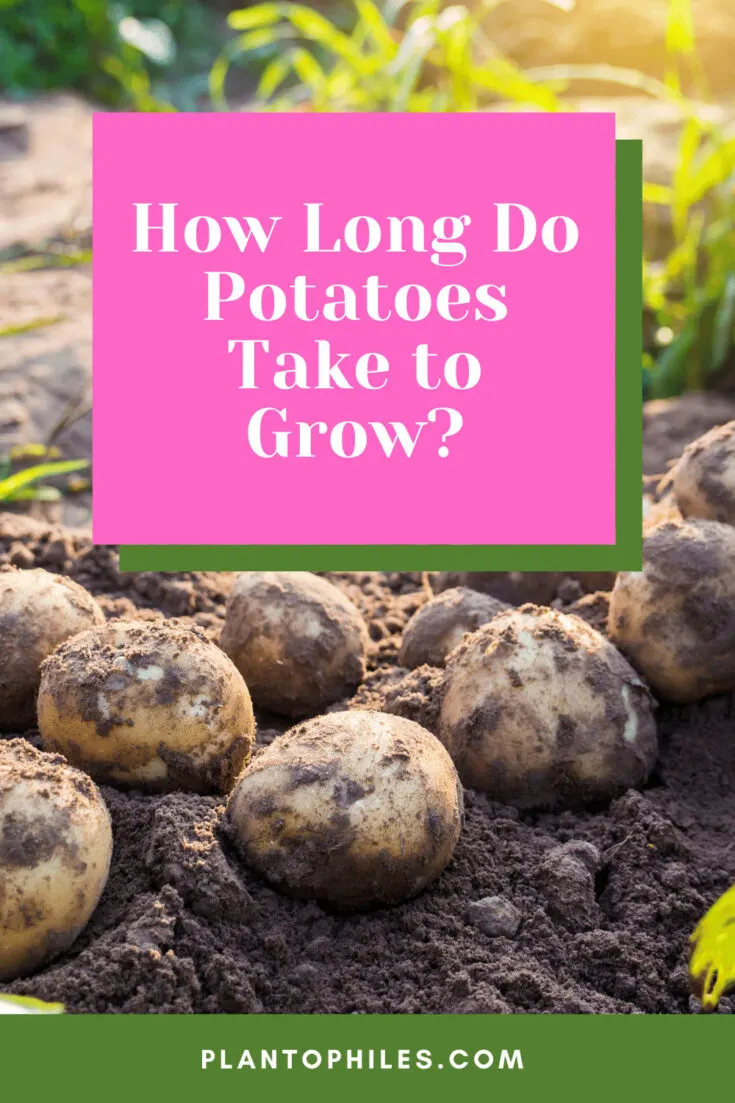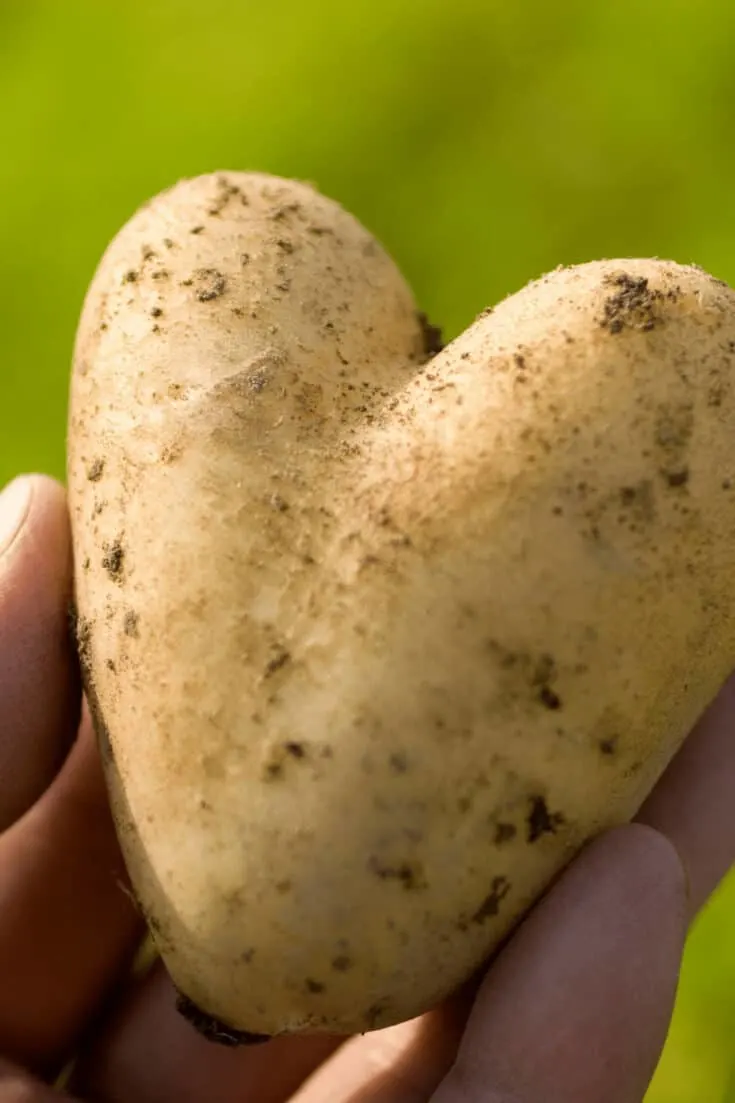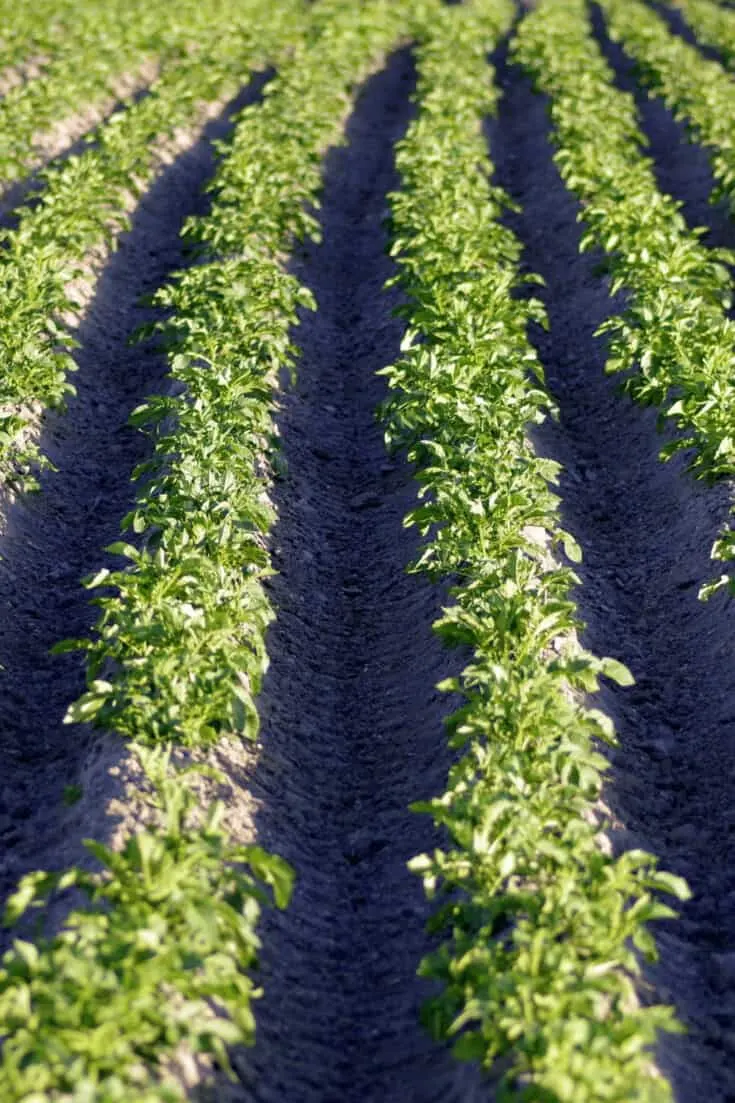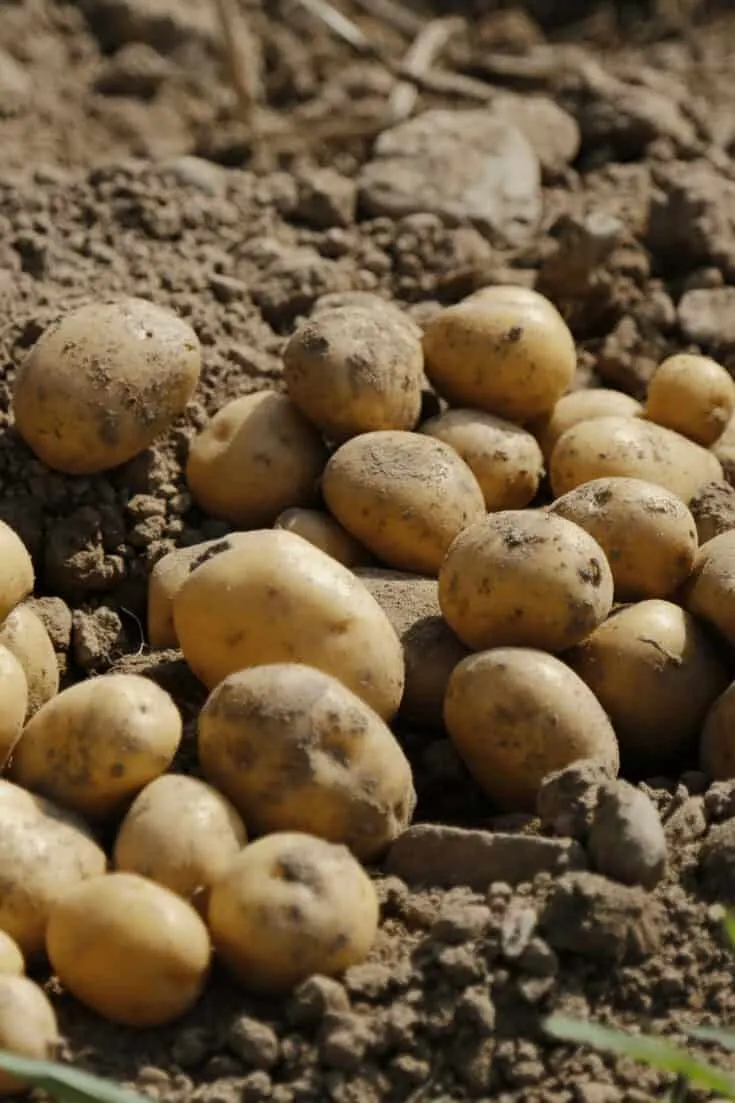How Long Do Potatoes Take to Grow?
Potatoes are hugely popular vegetables among children and adults.
Surprisingly, potatoes are also one of the easiest vegetables to grow.
If you like potatoes, why not grow your own?
Apart from how to grow potatoes, you may also ask yourself, how long do potatoes take to grow?
There is no straightforward answer to this question. So, if you want to find out, better stay and read the article below.
How Long Do Potatoes Take to Grow?
Potatoes take between 75 to 130 days to grow. If the potato variety you’re planting falls under the Early growing season group, you can harvest them around 70-80 days after sowing them. If, however, you planted a Mid-season variety, it’ll take up to 100 days before you can harvest them. As for the Late variety potatoes, you’ll have to wait for approximately 110 to 120 days, or even up to 130 days, before you can harvest them.

How Long Do Potatoes Take to Grow?
Table of Contents
Growth Time According to Variety
There are a lot of potato varieties available worldwide. In fact, there are over two hundred varieties of potatoes that you can find!
However, each variety of potato is categorized according to the season they’re most likely ready to be harvested.
Namely, these categories are:
- Early
- Mid-season
- Late
But, aside from being organized according to their growing season, potatoes are also categorized by their type.
In total, there are seven different types of potatoes. Namely, these are:
- White
- Yellow
- Red
- Purple
- Russet
- Fingerling
- Petites
Each type of potato is different and depending on the variety, they will take different periods of time to fully establish and grow.
You can harvest new potatoes just ten weeks after you planted them.
Other, full-sized potato varieties can take anywhere from seventy-five days to one hundred and thirty days or more before they will be ready to be harvested.
For potatoes that fall under the category of Early varieties, you can expect to harvest them in less than ninety days.
Typically, these types of potatoes will take between seventy days to eighty days to grow and be ready to be harvested.

Early growing season potatoes take 70-80 days to grow
Mid-season potato varieties take about one hundred days to mature. Although, it is not uncommon for them to take a little bit longer than that.
Late varieties of potatoes, however, can take anywhere from one hundred and ten days to one hundred and twenty days.
It is highly unlikely for the potatoes of this category to take anything less than one hundred and ten days or more.
In fact, it is quite possible for Late variety potatoes to take up to one hundred and thirty days before they will be ready to be harvested.

Mid-season potato varieties take up to 100 days to grow
The Potato Variety that is Best For You
Not all potato varieties are well suited to be grown in every area.
Although they are fairly easy-going vegetables to grow, they do still have their preferences when it comes to their growing environment.
Early potato varieties are the ideal growing season group for areas that experience warm temperatures in the summer. This group includes potatoes such as Orla, Rocket, and Yukon Gold.
Orla potatoes are a variety that is resistant to blight and makes for great salad potatoes!
Rocket potatoes are known to be one of the fastest-growing varieties.
Yukon Gold potatoes are a variety known to be more compact, meaning they can be planted closer to each other.
Among these three potato varieties are Belle de Fontenay, Sirtema, Chérie, Amandine and Annabelle. These are also potato varieties available for choice in the early season varieties.

Late variety potatoes take 110-130 days to grow
Mid-season potato varieties include types such as Mona Lisa, Charlotte, Rose of France, and Bernadette. Also in this category are Kipfler potatoes and Red potatoes.
Kipfler potatoes are the ideal potato for boiling and mashing as they are small.
Red potatoes have thinner skins than other potatoes. This attribute makes these potatoes perfect for roasting or using in stews or soups.
Charlotte potatoes have a texture that is waxy. They are great eaten hot or cold!
Finally, Late potato varieties are better suited for growth in areas that experience more mild temperatures during the summer.
Potatoes in this category include Vitelotte, Désirée, Caesar, Bleue d’Artois, Corne de Gatte, purple potatoes, and Russet potatoes.
Purple potatoes are high in anti-oxidants and, as their name suggests, have both purple flesh and purple skins.
Désirée potatoes, however, have skins of a pinkish color but yellow flesh. These potatoes are perfect for making mashed potatoes.
Russet potatoes are known to have skin that is thicker but flesh that is rather fluffy.

Potatoes take between 75 to 130 days to grow
Factors that Slow Down The Potato Growth Rate
There are a few factors that could contribute to the delay of your potato’s growth.
Potatoes can be affected by poor soil quality, diseases or pests, and seed potatoes that have been freshly cut.
The soil your potatoes are planted in could delay their growth if it is too wet, too dry, or even too cold. Potatoes need soil that is well-draining.
They also require a soil temperature of 40°F (4.5°C) at the very least.
If you notice your potato plants are taking longer than one hundred and fifty days to fully grow, this is a key sign that there is a problem with your plant’s soil.
Possible pests or diseases to be on the lookout for include:
- Leafhoppers
- Flea beetles
- Potato scab
- Aphids (more commonly known as potato beetles or bugs)
The most efficient way to solve a pest problem with your potatoes is by using an insecticide that is natural.
In the case of seed potatoes, it is vital that you do not use ones that have been freshly cut. Freshly cut potatoes used as seeds become dehydrated quickly and easily.
They also do not heal immediately. These two things are likely to result in the prevention of the growth of your potatoes.
Ways to Shorten Potato Growth Time
It is absolutely possible to shorten the time it takes for your potatoes to fully grow. But, to make this more effective, you should do the step before you even start planting your potatoes.
The process, called chitting, helps potatoes grow faster by allowing them to produce shoots before you plant them.
In order for your seed potatoes to chit, you will need to place them in a spot that is well lit. Leave them there for a couple of weeks.
Then, before planting, remove all of the shoots except for two of the strongest ones per seed.
Preparing your seed potatoes in this way will give them a head start and shorten their growing time a little bit.
Many claim that this process also produces a slightly larger harvest than the traditional method of planting them.
Best Way to Plant Potatoes
Selection
The first step in planting potatoes is finding the right variety for your needs and preferences.
The local climate and time of year are also important when making your selection.
In areas that experience shorter springs and summers with hot temperatures, Early or Mid-season potato varieties are ideal.
These potatoes should be planted about three weeks to four weeks before you experience the final frost.
Areas with springs that last longer and summers that are hot, Early or Mid-season potato varieties will be suitable.
These varieties need to be planted three weeks to four weeks before the last frost sets in.
It is also possible to plant the Late variety of potatoes. However, this variety should be planted early in the summer. Doing so will allow them to mature in the autumn.
Areas that experience cooler summer temperatures have the luxury of choosing any variety.
Early, Mid-season and Late varieties of potatoes can all be grown in this kind of environment. Two weeks to three weeks prior to the final frost is the ideal time to plant your potatoes.
Preparation and positioning
Once you have chosen a potato variety that best suits you and your location, the next step is getting ready to plant your potatoes.
To do so, you will need to ensure you have properly prepared your desired area.
Potatoes need an area that is both cool and dry in order to grow. Not only that but, it is also a good idea to choose a spot that receives direct sunlight for at least six hours per day.
Potatoes require loose soil that is fast-draining.
It is also necessary for the soil to be at a temperature of around 45°F to 55°F (7°C to 13°C).
To start, dig a trench for your potatoes about 6 inches (15 centimeters) deep.
The trench should be long enough to fit all of your seed potatoes in with a spacing of at least 12 inches (30 centimeters).
Multiple rows of trenches are perfectly fine so long as they too are spaced at least 12 inches apart.
Prepare the soil at the bottom of the trenches by digging in some manure or even some organic compost.
Once this has been done, you are now ready to actually plant your potatoes!
Planting
If you are planting small seed potatoes, you can plant them whole. If your seed potatoes are rather large, it is better to cut them into smaller sections.
When you cut potatoes into sections, make sure that each new section has an “eye”.
You will need to leave these freshly cut seed potato sections for a few days in order to dry out.
Allowing your cut seed potatoes time to dry and form a callous over the cut sides will help in preventing the sections from rotting once they have been planted in the ground.
Plant your seed potatoes at the bottom of the trenches you made. Remember to leave sufficient space for your potato plants to grow.
It is also possible, should you be short on space in your garden, to plant smaller potato varieties in large buckets or even grow bags.
For your potatoes to mature properly and as they should, planting them at the correct time is vital.
You can store your seed potatoes in the fridge until a week before they should be planted.
Taking your seed potatoes out of the fridge a short while before you plant them will take them out of their state of dormancy.
This will then prepare them for being planted.
How Many Potatoes Will I Harvest
You may be wondering how many potatoes you will get from your harvest. Again, there is no one set amount.
The number of potatoes you harvest will be determined not only by how many potatoes you sow.
The type of potato you sow is also a key factor.
If you only sow one potato, you should not expect to get fifty potatoes from your harvest.
As the old adage goes, you reap what you sow!
But that is not all. Different types of potatoes have different yields per plant.
Typically, with good care and ideal conditions, you can expect a harvest of around five potatoes to ten potatoes per plant.
The soil, nutrient availability, climate, and other factors will also play a part in the yield.
Conclusion
Potatoes are great vegetables to grow at home and get the whole family involved in gardening!
There are so many varieties available to choose from and they are not at all difficult to grow.
In fact, they are among the easiest vegetables to grow!
There are few things more rewarding than harvesting your own fresh healthy vegetables and potatoes are one of the easier options to grow.
Although they take some time to fully grow, the preparation needed to plant them as well as harvesting potatoes once they are grown is fun for both adults and children alike.
There are a few things that could hamper the growth of your potatoes.
However, with proper care and the right growing conditions, they will be just fine.

Daniel has been a plant enthusiast for over 20 years. He owns hundreds of houseplants and prepares for the chili growing seasons yearly with great anticipation. His favorite plants are plant species in the Araceae family, such as Monstera, Philodendron, and Anthurium. He also loves gardening and is growing hot peppers, tomatoes, and many more vegetables.

![How Long Do Potatoes Take to Grow? [Solved]](https://plantophiles.com/wp-content/uploads/2021/04/1-720x405.jpg.webp)
